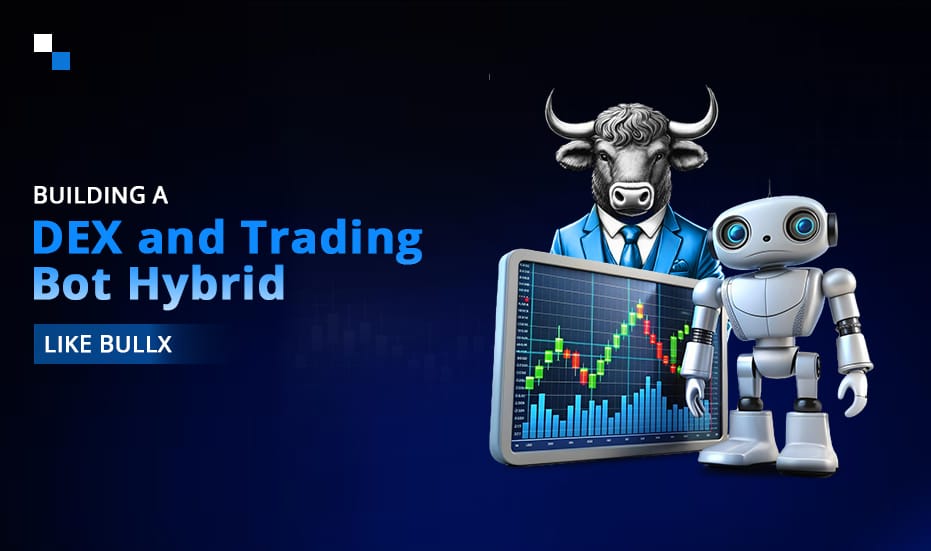
What are the Key Determinants Behind the Success of Your ICO Development Crusade?
March 14, 2024
6 Reasons to Venture into White Label Exchange Software Development in 2024
March 15, 2024In the ever-evolving world of cryptocurrency trading, automation has become a key strategy for traders looking to capitalize on market opportunities. One popular tool for automating trading strategies is a crypto trading bot. These bots are programmed to execute trades based on predefined criteria, allowing traders to take advantage of market movements without the need for constant monitoring. The growing popularity of trading bots has led to an increasing demand for crypto trading bot development.
Let us gain insights into trading bots and how to build them using Python.
What is a Crypto Trading Bot?
A crypto trading bot is a software program that interacts with cryptocurrency exchanges to execute trades on behalf of the user. These bots can be designed to perform a variety of functions, from simple buy/sell orders to more complex strategies such as arbitrage and trend following. By automating trading decisions, these bots can help traders react quickly to market changes and execute trades with precision.
Why Use Python to Build a Crypto Trading Bot?
Python has emerged as a popular choice for crypto trading bot development due to its simplicity, versatility, and extensive library support. Some key reasons to use Python for building a crypto trading bot include:
- Ease of Use
Python’s clean syntax and readability make it accessible for both beginners and experienced developers alike, allowing for rapid development and iteration of trading strategies.
- Vast Library Ecosystem
Python boasts a rich ecosystem of libraries and frameworks specifically tailored for financial and algorithmic trading, such as Pandas, NumPy, and Ta-Lib. These libraries provide robust tools for data analysis, visualization, and technical analysis, essential for developing effective trading strategies.
- Community Support
Python enjoys a large and active community of developers, traders, and enthusiasts, offering extensive documentation, tutorials, and forums for assistance and collaboration.
Set up a Crypto Trading Bot using Python and Antier’s Tools
Schedule Free DemoSteps to Build a Crypto Trading Bot Using Python Language
Step 1: Setup Environment
Setting up your development environment is the first crucial step in building a trading bot with Python. When you partner with a crypto trading bot development company to build a trading bot, their developers will have Python set up on their systems as a first step of development. The preferred version is the one that is compatible with the libraries that will be used. Additionally, consider using virtual environments like virtualenv or conda to manage dependencies and isolate your project environment, minimizing conflicts with other projects.
Step 2: Choose a Cryptocurrency Exchange
Selecting the right cryptocurrency exchange is paramount to the success of your trading bot. Look for exchanges that offer robust API capabilities, competitive trading fees, high liquidity, and a wide range of trading pairs. Popular exchanges like Binance, Coinbase Pro, and Kraken are commonly used by traders and offer well-documented APIs for integration.
Step 3: Design Trading Strategy
Designing a solid trading strategy is the cornerstone of effective trading bot development. Consider factors such as risk tolerance, investment goals, time horizon, and market conditions when formulating a strategy. Decide whether you will be implementing a trend-following, mean-reversion, or sentiment-based approach, and incorporate appropriate technical indicators and risk management rules.
Step 4: Implement API Integration
Once you have chosen your exchange, familiarize yourself with its API documentation and authentication methods. Most exchanges offer RESTful APIs for accessing market data, placing orders, and managing your account. Implement API integration in Python using libraries like Requests or a dedicated exchange wrapper library, ensuring proper error handling and security measures to protect your API keys and sensitive information.
Step 5: Data Acquisition and Analysis
Retrieve historical and real-time market data from the exchange using its API or third-party data providers. Common data points that can be considered by your crypto trading bot developers include price, volume, order book depth, and market sentiment indicators. Preprocess the data by cleaning, normalizing, and aggregating it into a suitable format for analysis. Leverage libraries like Pandas for data manipulation, NumPy for numerical computations, and Matplotlib or Plotly for visualization.
Step 6: Strategy Implementation
Translate your trading strategy into code using Python, incorporating the insights gained from data analysis. Define buy/sell signals based on your chosen indicators and trading rules, considering factors such as moving averages, relative strength index (RSI), MACD, and Bollinger Bands. Implement risk management techniques such as stop-loss orders, position sizing, and portfolio rebalancing to mitigate losses and maximize returns.
Step 7: Backtesting and Optimization
Backtest your trading bot using historical market data to evaluate its performance and profitability. Utilize backtesting frameworks to simulate trades and measure key performance metrics such as Sharpe ratio, maximum drawdown, and profit factor. Optimize your trading strategy by fine-tuning parameters, optimizing trading rules, and experimenting with different timeframes and assets to improve overall performance.
Step 8: Paper Trading and Live Deployment
Deploy your bot in a paper trading environment to validate its performance in real-market conditions without risking actual capital. Monitor its performance closely, track key metrics, and make necessary adjustments based on the results. Once satisfied with its performance, transition to live trading by connecting your bot to your exchange account and deploying it with caution, starting with small position sizes and gradually increasing exposure as confidence grows.
Crypto trading bot development with Python can be a rewarding endeavor for traders looking to automate their strategies and gain an edge in the competitive cryptocurrency markets. By following the steps outlined in this blog and leveraging Python’s capabilities, you can create a powerful tool that can help you navigate the complexities of crypto trading with efficiency and precision. Remember to continuously monitor and optimize your bot’s performance to adapt to changing market conditions and stay ahead of the curve in this dynamic industry.
Why Antier for Crypto Trading Bot Development?
Our crypto trading bot developers have real-world experience building powerful crypto trading bots that amplify the performance of crypto exchanges. Whether you want to integrate a trading bot into your existing crypto trading exchange or want to build a new exchange fortified with a trading bot, we offer customized solutions to cater to your needs.
Connect with our subject matter experts to discuss your needs for automated trading bot development.



